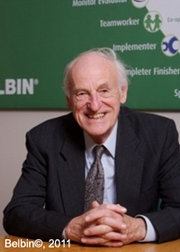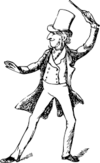Belbin's team roles
(→Project Human Resource Management) |
(→Abstract) |
||
| Line 1: | Line 1: | ||
==Abstract== | ==Abstract== | ||
| − | In the recent years there has been a higher interest in understanding how the different team members in projects behave at their workspace and how to create groups which have a high efficiency. These things get very interesting when a project manager has to make Project Human Resource Management, which is the process of identifying and documenting project roles, responsibilities, required skills, reporting relationships and creating | + | In the recent years there has been a higher interest in understanding how the different team members in projects behave at their workspace and how to create groups which have a high efficiency. These things get very interesting when a project manager has to make Project Human Resource Management, which is the process of identifying and documenting project roles, responsibilities, required skills, reporting relationships and creating acquire project teams. <ref name="PMI13"> 2013 Project Management Institute, Inc. A guide to the Project Management body of knowledge. </ref> Acquire Project team is the process of confirming human resource availability and obtaining the team necessary to complete project activities. And to do this the project manager needs tools to identify which team members fits into which team role and here can Belbin's team roles be useful. |
The Belbin team roles is developed by Dr. Meredith Belbin and contains 9 different team roles. The last team role, the specialist, was added in 1988. The method can help you identify the different team members strength and weaknesses. This can be used in all different kinds of projects and can help you create a team which have a high performance and efficiency. Belbin's team roles theory looks at how people behave in team work and which roles suits the different team members best. The Belbin team roles assessment is done by a certified Belbin consultant. The method is used by over 40 percent of the top 100 companies in the UK, the united Nations, the Worlds Bank and thousands of organizations throughout the world to enhance individual and team performance. <ref name="Belbin_associates"> 2018 Belbin Associates. http://www.belbin.com/</ref> | The Belbin team roles is developed by Dr. Meredith Belbin and contains 9 different team roles. The last team role, the specialist, was added in 1988. The method can help you identify the different team members strength and weaknesses. This can be used in all different kinds of projects and can help you create a team which have a high performance and efficiency. Belbin's team roles theory looks at how people behave in team work and which roles suits the different team members best. The Belbin team roles assessment is done by a certified Belbin consultant. The method is used by over 40 percent of the top 100 companies in the UK, the united Nations, the Worlds Bank and thousands of organizations throughout the world to enhance individual and team performance. <ref name="Belbin_associates"> 2018 Belbin Associates. http://www.belbin.com/</ref> | ||
| Line 9: | Line 9: | ||
__TOC__ | __TOC__ | ||
| − | |||
| − | |||
==Dr. Meredith Belbin== | ==Dr. Meredith Belbin== | ||
Revision as of 14:22, 20 February 2018
Abstract
In the recent years there has been a higher interest in understanding how the different team members in projects behave at their workspace and how to create groups which have a high efficiency. These things get very interesting when a project manager has to make Project Human Resource Management, which is the process of identifying and documenting project roles, responsibilities, required skills, reporting relationships and creating acquire project teams. [1] Acquire Project team is the process of confirming human resource availability and obtaining the team necessary to complete project activities. And to do this the project manager needs tools to identify which team members fits into which team role and here can Belbin's team roles be useful.
The Belbin team roles is developed by Dr. Meredith Belbin and contains 9 different team roles. The last team role, the specialist, was added in 1988. The method can help you identify the different team members strength and weaknesses. This can be used in all different kinds of projects and can help you create a team which have a high performance and efficiency. Belbin's team roles theory looks at how people behave in team work and which roles suits the different team members best. The Belbin team roles assessment is done by a certified Belbin consultant. The method is used by over 40 percent of the top 100 companies in the UK, the united Nations, the Worlds Bank and thousands of organizations throughout the world to enhance individual and team performance. [2]
This article will help you understand how, when and why you should use Belbin team roles and will discuss the limitations of using Belbin's team roles.
Contents |
Dr. Meredith Belbin
Dr. Meredith Belbin has a doctor degree in psychology from Clare College in Cambridge. After some time studying at Clare College in Cambridge he decided to switch courses to Psychology, where he completed a two-year course in half the allotted time. After this he started studying for his PhD, focusing on the psychology of ageing in industry. He has been an active management consultant in more than fifty years for many different international and private firms. He is a professor and researcher at Henley Business School in Oxford shire, England. [3]

Dr. Meredith Belbin was born in 1926 [3] and is married to Eunice, who he meet in the psychology courses at Clare college in Cambridge.
He originally identified the Team Roles as a part of a study of teams. This took place at Henley Business School. These studies included a business simulation game. He was invited in 1969 to use this business game as start if a study of team behavior [2] His research gave two very important results. The first result showed it was possible to find and isolate nine different team roles, which could describe the inner psychological dynamic in a person as well as to describe the effects will have, partly on the employees and partly on the team. The second result was to make it possible to predict how well the team will perform from the different compositions of the nine team roles. [5]
In the last couple of years Dr. Meredith Belbin has visited China and Rusia to speak about the applications of the Team Roles in different cultures. [2]
Belbin's Team Roles
Belbin's team roles theory is not looking at peoples personality but is looking at the type of work which is most suited for each person, based on their work behavior. Dr. Meredith Belbin defines a team role as "A tendency to behave, contribute and interrelate with other in a particular way." [2] The theory consist of 9 clusters of behavior that individuals adopt when participating in a team.
| Team Roles | Characteristics/Contribution | Allowable weakness | Function |
|---|---|---|---|
| Plant (PL) | Plants are innovators and inventors and can be highly creative. They provide the source of original ideas to support innovation. Usually they prefer to operates by themselves at some distance from other team members, using their imagination and often working in an unorthodox way. They tend to be introverted and react strongly to criticism and praise. their ideas may often be radical and may lack practical constraints.
They are independent, and usually regarded as being clever as a results of their original and radical perspective. |
They don't always manage to communicate in a compelling way and offer their ideas in a practical and relevant framework or they can be able to ignore incidentals because they can be too preoccupied. | The main use of a Plant is to challenge conventional and established ways of doing things and provide suggested solutions for solving complex problems. Plants are often needed in the initial stages of a project or when a project is failing to progress. Plants have usually made their mark as founders of companies or as originators of new products.
However, too many Plants in one team or group may be counter-productive as they tend to spend their time reinforcing their own ideas and engaging each other in combat. |
| Resource Investigator (RI) | Resource Investigators are usually enthusiastic extroverts. They are natural communicators with people, inside and outside the company. This means that the Resource Investigator is the networker of the group. They are natural negotiators and are adept at exploring new opportunities and developing contacts. Although not a great source of original ideas, the Resource Investigator is effective when it comes to picking up other people's ideas and promoting them. As the name suggests, they are adept to find what is available and from whom. They usually receive a warm reception from others because of their warm outgoing nature.
Resource Investigators are generally relaxed people with a strong inquisitive sense and a readiness to see the possibilities in anything new. The Resource Investigator may appear to be flighty and inconstant, but their ability to call on their connections is useful to the team. |
The team member can be over optimistic and can lose interest once initial enthusiasm has passed. | Resource Investigators are good at exploring and reporting back on ideas, developments or resources outside their immediate group. They are the natural people to set up external contacts and to carry out any subsequent negotiations. They have an ability to be fast thinkers and to probe others for information. |
| Co-ordinator (CO) | The distinguishing feature of Co-ordinators is their propensity for helping others to work towards a shared goal. They are mature, trusting and confident, they delegate readily. In interpersonal relations they are quick to spot individual talents and to use them in pursuit of group objectives. While Co-ordinators are not necessarily the cleverest, they are likely to have a broad outlook and perspective. The natural goal focus of Co-operator’s can sometimes lead to them manipulating others to achieve their personal objectives. In some situations Co-ordinators are inclined to clash with Shapers due to their contrasting management styles.
The Co-ordinator seeks fairness and equity among team members. Those who want to make decisions quickly, may feel frustrated by their insistence on consulting with all members, but this can often improve the quality of decisions made by the team. |
This team member can be seen as manipulative person and as a person who offloads personal work. | Co-operators are well placed when they are put in charge of a team of people with diverse skills and personal characteristics. They perform better in dealing with colleagues of near or equal rank than in directing junior subordinates. Their motto might well be "consultation with control" and they usually believe in tackling problems calmly. |
| Sharper (SH) | Shapers is a dynamic team member. Shapers are highly goal and oriented people with great drive and energy. They push themselves and others and tend to overcome obstacles by sheer determination. They tend to be highly assertive and have very directive management styles. Shapers loves a challenge and thrives on pressure. They frequently progress upward in organizations because they get results and because many people are impressed by their courageous and decisive leadership style. they drive and courage team members to overcome obstacles. | This person can be prone to provocation and offend people’s feelings. Shapers are not noted for their interpersonal sensitivities and can be argumentative and even aggressive. | Shapers are generally perceived as ideal managers because they generate action and thrive under pressure. They come into their own when quick and decisive action is called for to overcome threats and difficulties or when progress towards goals and objectives is unacceptably slow. |
| Monitor Evaluator (ME) | Monitor Evaluators is a strategic and discerning member, who tries to see all options and judge accurately. They are serious-minded, prudent individuals with a built-in immunity for being over-enthusiastic. They are likely to be slow in making decisions preferring to carefully think things over. Usually they have a high critical thinking ability. They have a good capacity for shrewd judgements that take all factors into account. A good Monitor Evaluator is unlikely to make intuitive and reckless mistakes. They deal in facts and logic rather than emotion when
considering options. |
They are often regarded as over-critical and can be seen to be slow and boring. They can lack drive and ability to inspire others. | Monitor Evaluators are best suited to analyze problems and evaluate ideas and suggestions. They are very good at weighing up the pro's and con's of options. In a managerial position their ability to make high quality decisions. |
| Team Worker (TW) | Team Workers possess a mild and sociable disposition and are generally supportive and concerned about others. They seek to endure that interpersonal relationships in the team are maintained. They have a great capacity for flexibility and adapting to different situations and people. Team Workers are perceptive, diplomatic and carrying and tend to be good listeners. Because of these qualities they are popular with their colleagues. | Their concern about creating harmony and avoiding conflict can make them indecisive when faced with having to make difficult solo decisions. This means that they can be indecisive in crunch situations. | The Team Workers may be legitimately compared to the lubricating oil in a car engine. We don’t always appreciate how important it is until it isn’t there. Because of their ability to be able to resolve interpersonal problems Team Workers come into their own when situations are tense, and people feel uncared for and underappreciated. They can rise to senior positions because they have few enemies and the fact that they are ready to listen to the views and suggestions of others. |
| Implementor (IMP) | Implementers are characterized by their practical approach and possess higher than normal levels of self-control and discipline. They are prepared to work hard to ensure things are done as prescribed in a systematic way. They are typically loyal to the organization and prescribed and established ways of doing things. They are likely to be regarded as someone who will not seek personal agendas and self-interest. | On the downside Implementers may be inflexible in accepting new ways of doing things, particularly if they are radical or impracticable. They may frustrate other team members by their perceived lack of enthusiasm for inspiring visions and radical ideas into workable solutions is important. | Implementers are valuable in an organization because of their reliability and capacity for application. They succeed because they are efficient and because they have a sense of what is feasible and relevant. While many people might stray favoring the tasks they like to do and neglect things they find not to be to their liking an Implementer is more likely to do what needs to be done in a systematic way. |
| Completer Finisher (CF) | Completer Finishers have a great capacity for the attention to detail. They constantly strive for perfection and correct errors. Completer Finishers are quite introvert and require less external stimulus than most people. The Completer Finisher can be trusted to do work to the highest standard and to complete it on time. | The combination of striving for perfection and meeting deadlines often creates anxiety though and Completer Finishers are likely to be reluctant to trust others to do work to their own high standards. They are inclined to worry unduly and reluctant to delegate. | The Completer Finisher is invaluable where tasks demand close concentration and a high degree of accuracy. The standards they set make them well suited to situations where precision and high standards are essential. Completer finishers will also demand the same high standards from people around them and therefore create their own micro culture where the only standard acceptable is perfection. |
| Specialist (SP) | The last team role, the ninth role, was added in 1988. This team role is the Specialist. The specialist brings expert knowledge to the team. The Specialist Team Role and the functional title of Specialist is often a cause for confusion. While it is true that both uses of the term may relate to people who are a source of technical knowledge and expertise the Specialist in Team Role terms has some very specific attributes. Their main distinguishing feature is their love of learning. They see learning
and the accumulation of knowledge as the main reason for their existence and their single minded and resolute pursuit of this end is their main motivation. The Specialist is likely to be recognized by colleagues as an expert to turn to for help and guidance. |
The Specialist will usually try to avoid being involved in unstructured meetings and discussions or those of a social nature. They may also be somewhat unyielding when challenged about the validity of their knowledge or field of expertise. This person contributes on only a narrow front and dwells on technicalities. | While Specialists may not be regarded as natural team players teams will be wise to engage the Specialist as a means of providing in depth research. As managers, they command respect because of their in-depth knowledge and they can be used to mentor others to raise their technical expertise. |
In this table all there is written in Characteristic/Contributions is found in the article Team Weaver [4] and in the article Belbin for students. [2] The Allowable weakness is found in the Belbin Team Role summery. [2] The functions is found in the article Belbin for students [2].
The Allowable weakness' tells us about some of the weaknesses there can be in the different team roles. For example can a strength in one role can be seen as a weakness in other context. This could be if a person who prefer the Team Role as the Monitor Evaluator is likely to be objective, impartial and good at carefully weighing up all possibilities to make the right decision. But someone with these strengths may come across to other team members as being unenthusiastic or even boring. If they are failing to inspire is tending to obscure the true strengths of a Monitor Evaluator. That weakness can be reckoned the price that necessarily has to be paid for the strength and in this sense it is termed Allowable.
These team roles, which can be seen in the table above, can be divided in action-oriented roles, people-oriented roles and Thinking-oriented roles.
Action-oriented Roles
- Shaper
- Implementer
- Completer Finisher
people-oriented Roles
- Co-ordinator
- Teamworker
- Rexource investigater
Thinking-orientated Roles
- Plant
- Monitor Evaluator
- Specialist
Application
How to use the method
The Belbin team analysis evaluates each team role and sort them into three categories, which can be seen bellow. [6]
- Your naturally strong team roles, is the team roles you are strong in and therefore have the preferences to use them. Often you have 2-3 team roles you are naturally strong in.
- Team roles you can act in, should be given to other team members, if they are strong i these roles. If there is not anybody who is naturally strong in these team roles or have the preference to be in the team role, you should take the role.
- At the last team roles is the team roles you should avoid and therefore it is important that another team members have these qualities.
The team members work best in their naturally strong team roles. Therefor should they always work in these team roles, so they can used their forces. If all the team members work in their naturally strong team roles will the team work, be very effective in all phases of the projects. These also means there will be less conflicts during the team work.
To find your naturally strong team roles by using Belbin's team roles, you need to answer a lot of questions about yourself. From all these answers the certified Belbin consultant will make an assessment and then make a statement of which team roles are your naturally strong team roles and which team roles you should leave to others.
Why use this method
The results you get after working with the Belbin Team roles theory is a better understanding of your team members and understanding of how and why they act the way they do. In this way you still get a better understanding of: [6]
- How to control and result different conflicts.
- How can a team be effective.
- The recognition of dissimilarity.
- How to communicate better in your team.
It is very important for a project manager to have efficient and open communications with the team members and between the team members. [1]
When is it applicable
Belbin's team roles are a good tool when you are trying to get more loyal and happy team members. Belbin's team roles method is very ideal tool to apllicate when you are working against: [7]
- More effectives teams.
- Better cooperation between team members.
- Better communication in the teams.
- Promote helping other team members and be more supporting inside the teams.
- Less conflict inside the teams.
- Better work environment.
- More respect for the individual and team goals.
- Create a shared perception of team roles.
Limitations
There is limitations or considerations to Belbin's team roles theory and some of them is given here:
- Sometimes the team activities change during a project. This means that it is not also possible to keep the same team role during a project.
- This theory does not take into considerations that there can be hierarchi between some people working in teams. [8]
- When creating groups it is important not only to make teams who can work effective by following Belbin's team roles theory but to think about that some people do not like eachother or just can not work together.
- Persons cannot only be evaluated/measured on their team related behavior. There are other factors there need to be kept in mind, this could be their personality. The Belbin team roles theory is not a psycological method and there it does not take the personality in count. But Belbin's team roles theory can be used to find clusters of behavior, which if effectively deployed in a team will result in improvements in the team performance.[9]
ADD MORE
Annotated Bibliography
A Guide to the Project management body of knowledge (PMBOK Guide)
The PMBOK Guide
Belbin associates http://www.belbin.com/
This website provides a basic knowledge about who Dr. Meredith Belbin is and the thoughts about Belbin's team roles. It also tells about the 9 different team roles and their allowable weaknesses.
ADD MORE
References
- ↑ 1.0 1.1 2013 Project Management Institute, Inc. A guide to the Project Management body of knowledge.
- ↑ 2.0 2.1 2.2 2.3 2.4 2.5 2.6 2018 Belbin Associates. http://www.belbin.com/
- ↑ 3.0 3.1 2012 Van Vlient. Meredith Belbin. https://www.toolshero.com/toolsheroes/meredith-belbin
- ↑ 4.0 4.1 2011 Michael Costello. Team weaver.
- ↑ 2018 potential. Dr. Meredith Belbin http://potential.dk/belbins-9-teamroller/dr-meredith-belbin/
- ↑ 6.0 6.1 2004 Consultants in personality tests. Belbin’s team roles. http://www.persontests.dk/personlighedstests/belbin/
- ↑ Pernille Hjortkjær. Why choose Belbin team roles? https://pe3a.dk/hvorfor-belbin-team-udvikling-roller/
- ↑ 2018. 12 Manage. Limitations if the Belbin team roles method. Disavantages. https://www.12manage.com/methods_belbin_team_roles.html
- ↑ Max Isaac. The limitations of Belbin. https://www.12manage.com/methods_belbin_team_roles.html








